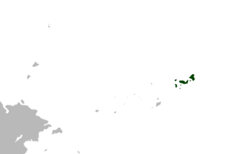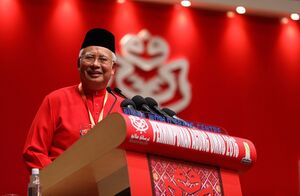Truk
Script error: The module returned a nil value. It is supposed to return an export table.
Truk Autonomous District 椰子岛 | |
|---|---|
Subject of the Democratic Republic of Daxia | |
 | |
| Special Subject | Daxia |
| Capital and largest city | Imarli |
| Official languages | Daxian |
| Ethnic groups |
|
| Religion | Islam |
| Government | |
• District Governor | Abdurrahman Mokhtar |
| Legislative Diwan | |
| Population | |
• 2030 estimate | 1,026,985 |
| Gini (2030) | medium |
| HDI (2068) | medium |
Truk or the Truk islands (Daxian:椰子岛) is a territory of the Republic of Daxia consisting of an archipelago with six islands. The islands are Iman, Hutau, Sinta, Chunma, Anako and Parapo. The archipelago is located on the eastern end of the Polynesian Sea far to the southwest of Vallos and east of Rapa Rapa. The islands saw the rise of the independent muslim Emirate of Truk in the 13th century before its conquest 400 years later by Daxia during the capture of Truk. Today the islands are an important waystation for oceanic trade between eastern Audonia and Sarpedon and Vallos and also a tourist destination for visitors from mainland Daxia. The local economy is mostly dependent on tourism, commercial fishing and ship insurance services; the traditional saltpeter industry mostly drying up in the 19th century due to failing mines. Truk has long had an autonomous government, which has contributed greatly to social and political stability and also the thriving of political Islam on the island. The island is currently governed by the People's Justice Party with the PCD as junior coalition partner.
History
Prehistory
The archipelago is believed to have been settled by Polynesian peoples since at least 600 BCE, with cave pictograms and tool remnants being recovered pointing to that period. The ancestors of the people of Truk might have been stragglers left behind from those that went to Vallos or simply a community that saw the islands as fit to settle on. The name of the pre-islamic civilization of Truk is extrapolated from engravings in pottery as the Karo. Early Karo peoples survived from fishing, gathering mussels on the shore and picking fruit; game was very rare limited only to small birds and rodents. Over time the Karo of Sinta and Anako sailed east and spread to the other islands of the archipelago, such that Karo settlement spanned all of the islands. Discovery of stone foundations and burial sites allow archeologists to estimate the existence of at least sixteen different sites that could have been habitated in this early period.
The emergence of the Melat kingdom on the island of Parapo can be traced back to the second century and lasted into the 9th century, asserting its control over all of Truk as is attested by large stone steles on each island declaring the glories of the rule of King Pokok(believed to have been between the years of 327 to 355). It is under the Melat kingdom that the settlement that became Imarli was founded, it was not however the capital or even an important settlement until after the kingdom had been destroyed. All references of Melat and its kings abruptly stop in the year 907. It is theorized that an invasion by other migratory polynesians took place that a the very least demolished the political and societal structures of Melat. The invaders did no reestablish any political structure of their own, instead plunging the islands back into basic tribalism. Fragments of oral tradition call the following years as the Jaws of Hunger, a two hundred year period of extreme deprivation and inter-communal violence that also led to technological and societal regression.
Eventually a tribe known as the Bagus that was directly descended from one of the noble families of the Melat era began forming alliances through marriage with other 'originator' tribes. King Eka of the Bagus proclaimed (as attested in clay tablets dated to 1101) anyone descended from the invading tribes as unclean ones, to be killed without exception. Thus the Bagus and allied tribes started a period of great bloodletting, including the ritualistic consumption of their enemies. The shocking violence reasserted the primacy of the older settled tribes over the newer ones but also greatly depopulated Truk. As one of the few settlements in habitable state, Imarli was chosen by the Bagus to serve as their new capital.
Emirate of Truk
See also: Capture of Truk
In the year 1251 an Islamic mystic by the name of Sayed Ali Qumi arrived by accident on the islands with a few companions after being shipwrecked in a storm. Qumi proceeded to successfully spread Islam to the people of Imarli by recounting the martial prowess of the Oduniyyad caliphs As the people of Truk did not have alcohol or pigs, forbbiding their consumption was not an obstacle to conversion. The King of Truk of the day adopted the islamic first name of Akhmat Bagusid to signal his new piety and began to style himself as emir, in imitation of Muslim rulers under Oduniyyad suzerainty. Under the Bagusids, the damage done to the islands during the Jaws of Hunger was undone and a prosperous merchantile society was built up as Truk began building bigger ships capable of ocean exploration. Imarli was known during this period as the Jewel under the Sun and the palaces and masjids of the Bagusids were adorned with fine carpets, mother of pearl and exotic woods and silks. Truk's relative geographical isolation in this early period allowed it to expand at its leisure to nearby islands such as Rapa Rapa, taken under the Emir's protection in 1265. Traditional notions of clan loyalty and kingly veneration were useful tools in the consolidation of the Bagusids and their power; internal upheaveals were a rare thing and crisis only came with the arrival of foreign vessels on the Polynesian Sea.
Initially appearing merely as explorers, in the following decades Levantians, Sarpedonians and Daxians would sail to Truk to peddle their goods, petition the Emirs for transit rights and protection and also at times to deliver threats. To survive, Truk's wily rulers managed to tiptoe around the various powers and avoided committing themselves to any one side for too long, making Truk an important component of the southern route and the Audonia-Sarpedon trade and taking advantage of the cultural and economic exchanges on offer. Beginning in 1642 Emir Mahmud Tidore II agreed to a loose compact with Daxia to counter encroachments by the Carto-Pelaxian Commonwealth; a possible fatal misstep as the Daxian court saw the agreement as much more binding and formal than the Bagusids ever did. Mahmud allowed the Daxians to build a fort on the island of Anako; the emirate's forces also received some shipments of weapons such as muskets to increase their battle worthiness. In return for their protection, Mahmud sold them pearls, saltpeter, sago(a type of starch used for bread) and cassava at greatly discounted rates In time the Daxians would also station a permanent representative on to the Bagusid court to oversee relations with the emirate and steer its policies to a pro-Daxian stance. Emir Mahmud's foreign policy caused a split with his son and heir, Prince Akhmat, and when the emir got sick in 1674 his son took the opportunity to launch a palace coup and usurp his father's place.
Daxian Rule
Economy
Government and Politics

Truk is unique in Daxia in that it is governed by an almost fully autonomous administration and legislature. These bodies have complete authority regarding lawmaking, taxation and expenditure; the exception to their powers are the areas of national defense and relations with foreign policy which are handled from Mirzak. The unicameral, sixty-seat Legislative Diwan is elected once every four years by single non-transferable votes from fixed constituencies. The District Governor is nominated by the largest party (must be a member of the Diwan and is usually the party leader) in the Diwan and must be ratified by a simple majority; he may be unseated by a two thirds majority vote and cannot be recalled by the population. The Daxian government may employ a veto on national security reasons, but it has never been used. Currently the government is led by a coalition of the local People's Justice Party and the Party of Daxian Democrats; together they have thirty nine seats in the Diwan.
Recently an uptick in support for political Islamism has been registered in Truk, especially on the islands of Anako and Hutau. Currently the largest opposition party in the Diwan is the Islamic Development Party, who numbers within its political program the implementation of strict Sharia law, a ban on alcohol and the inclusion of corporal punishment in the criminal code; among other items.
